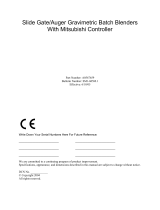
ADDITIVE (PERCENT OF ALL NATURALS)
Components designated ADDITIVE will be added as a percentage of all the
NATURALS added together. For example: If component 5 is an ADDITIVE
at 5 percent, Then the above example now looks like this:
component 1, REGRIND, SET=20.0, 20 percent,
component 2, NATURAL, SET= 10, 15.2 percent,
component 3, NATURAL, SET= 40, 61.0 percent,
component 4, ADDITIVE, SET=05.0, 3.8 percent.
The REGRIND is still 20 percent of the MIX.
The NATURALS are still at a RATIO of 1 to 4, although they have been
reduced to make room for the Additive.
The ADDITIVE is 5 percent of the NATURALS added together (5% of 76.2).
WHY do we do it this way? Because this is how most plastic processors
think of these components. REGRIND is generally only added when
available, and then as a limited percentage of the entire mix.
NATURALS are generally blended at a RATIO to one another. ADDITIVES
are most often only intended to be added to the entire NATURAL portion
of the mix, because regrind generally already contains these additives.
ON THE OTHER HAND:
If you prefer to think of your mix as a RATIO OF WEIGHTS, for example,
components 1, 2, 3, 4, and 5 are to be mixed at 100, 50, 5, 20 and 7
pounds respectively, then you may wish to specify ALL components as
NATURALS. In this way these weights may be entered just as listed
here. Components will be dispensed to maintain each at the proper
specified RATIO to the other components.
If you wish to think of all components as PERCENTAGES of THE MIX,
percents that always add up to 100, specify ALL components as REGRIND
and enter the exact percent for each. When ALL components are
REGRINDS, ALL settings must add up to 99 or 100 percent. If they do
not, an error message (REG >100) or (REG <100) will appear.
BUT... WE RECOMMEND that you do it this way:
REGRIND. Use this for all materials that DO NOT require the addition
of the ADDITIVES. For example, your Regrind scrap.
NATURAL. Use this for all materials that are the bulk of the mix.
These will be RATIOED to each other and will automatically constitute
the ENTIRE mix except for the space needed for Regrind and Additives.
A blend of ABS Homo-polymer and Co-polymer or a blend of Styrene Hi
Impact and Crystal are examples of NATURALS ratioed together.
ADDITIVES. Use this for all materials that are added to the NATURALS
only. For example; color, stabilizer, slip agent, etc.
+-----------------------------------------------------+
¦ PROCEED TO: SET MATERIAL TYPES NEXT PAGE ¦
+-----------------------------------------------------+
Page 17






















